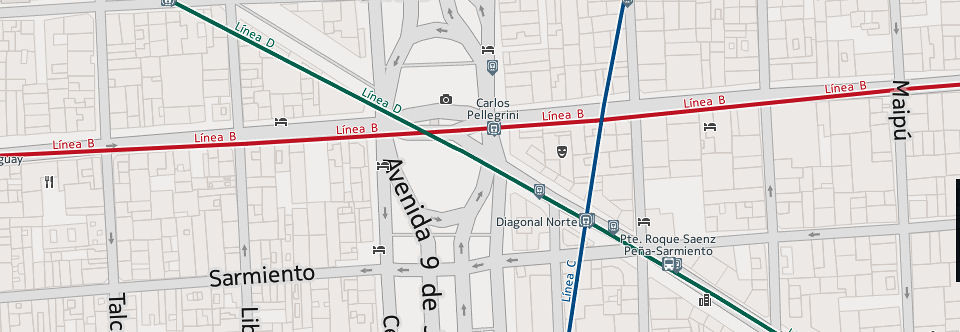Walking through the streets of Buenos Aires I was initially very much lost until I started realise that it was constructed in one massive grid – like many cities – with larger arterials running east-west and north south. Libertador, Santa Fe, Córdoba, Mayo/Rivadavia, Independencia, San Juan arranged east-west named from north to south and intersecting are the north-southers from east to west is 9 de Julio, Callao, Pueyrredón. Then I plotted the Subte lines, learned the bus routs running along the big avenues and could then place the various suburbs within this grid. The suburb of Recoleta could also be known as the area between Avenidas Libertador and Córdoba, from Avenidas Callao to Coronel Díaz. It then becomes possible to plan transport routes without help. The smaller streets are largely one way and named after countries or towns. Bus routes will go down one street in one direction and its corresponding neighbour in the other direction.
These cities are all circuit boards, operated like computers which is I think why street directories use grid-lined pages. Get the concept, and then you creatively plan within the structure. Following from this is the natural familiarity that comes with walking streets a number of times. Every new place could be referenced back to the known structure and then included within it. Patience, a friend like Cony, plenty of walking, a very good maps application from Nokia and a mobile-friendly webpage which tells you which bus to take if you put in the addresses all contributed to this knowledge. I know Buenos Aires better than I know central Melbourne.
Buenos Aires’ transportation system is an acquired taste and takes some getting used to. It leaves anything in Australia for dead in terms of volume and size.
TRAINS run to the furtherest extremes of the greater Buenos Aires, they are cheap and slow, but comparatively fast for the central city area because it’s not as packed as the Subte and doesn’t have traffic issues like busses. A 50km round-trip to Tigre cost me 3.30 pesos or 40c.
SUBTE (or subway) is hot and over-crowded and closes at 10pm. But if it stops at your intended destination it is faster than any bus option. Cost is 2.5 pesos no matter the distance. There are six lines, each colour coded and given a letter from A to E and also H. Only operates within the designated city of Buenos Aires, which is to say, within the area outlined by Avenida General Paz that makes a big circle around the central part of the city.
BUSES will blow your mind. Hundreds of lines run to all areas at all hours. Most of the time, the many thousands of busses are uncomfortably full. It is not rare to see two or three of the same busses right behind each other – I saw five. Often each line has different routes (A,B,C,D etc.). The cost is very cheap, only 1.5 to 1.7 pesos per trip if you have a SUBE public transport card, or 3.25 pesos regardless the distance if you pay in cash. Only coins are accepted which are difficult to find in regular quantity in Argentina.
TAXIS are everywhere. The counter starts at 10 pesos and most trips are around 30 pesos for shorter distances. Much more expensive, but with a good exchange rate of dollars to pesos it is quite cheap compared to Australia. Tales of horrendous rip-offs for tourists are not rare, but if you keep your head about you, you’ll be fine.
Argentina has a very large and efficient ‘interstate’ bus system. From the bus Terminal in Retiro, one can travel to all parts of the country at half the cost of flying. Comfort and service offerings vary but in general there are three options for long-hauls. Semi-cama, which is to say a seat that reclines a bit. No food. Full-cama, which despite the name, isn’t actually a proper bed but simply reclines a little more and includes food. And 1a clase, which is the actual reline-to-flat option, entertainment, food and in some cases, WIFI. The food is horrible, order vegetarian when you purchase your ticket and don’t expect there to be WIFI even if you paid for it. But the busses are comfortable, well equipped, efficient and very well priced.












